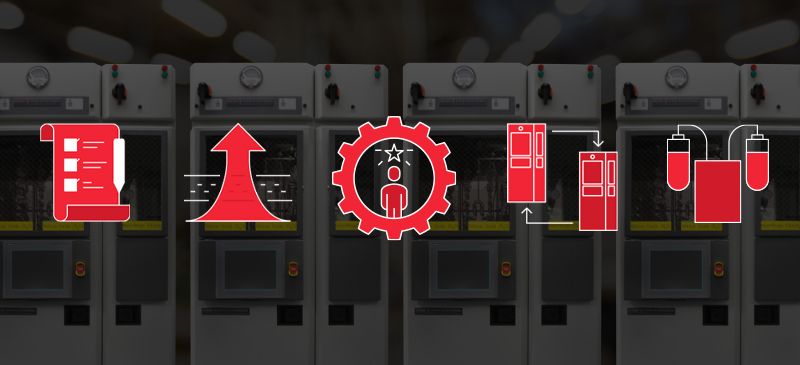
Discover a Better Bulk Gas Delivery System: 5 Things to Look For
Today’s digital transformations have driven growth in the semiconductor industry, with the 300mm silicon wafer market expected to increase by 5% in 2021. Along with this growth has come a greater pressure on fabs to increase output.
Bulk gas delivery systems that support higher flow rates can solve this need—but they come with engineering hurdles that must be overcome. In particular, there are unique thermodynamic challenges when handling larger flows, and as a result, safety and reliability can be compromised by under-equipped delivery solutions.
The Benefits and Challenges of Bulk Gas Delivery Systems
There are many benefits of bulk gas delivery systems, including longer run times, reducing the risk of human error, and maximizing production uptime. However, bulk gas systems have their challenges—particularly related to heating. To safely reach higher flow rates, gases must be properly and reliably heated to maintain a consistent temperate. Additional complications arise when adding a system into an existing building as bulk gas delivery equipment is often large, making it difficult to place bulk systems close to the source.
To take advantage of the benefits of a bulk gas delivery system, you must critically evaluate the features available to ensure you are achieving the output benefits of a bulk system without compromising on safety and performance. Below are five key factors to consider when looking for a winning system.
- The System is SEMI S2 Certified.You should ensure that the bulk gas delivery system is SEMI S2 compliant, meaning it upholds the standards set forth by SEMI for the safety and design of the equipment. For bulk gas delivery equipment, this means that systems should be shown to comply with requirements for hazard alert labels, safety interlock systems, emergency shutdown, hazardous energy isolation, seismic protection, and more.
- The System Has a Proven Heat Model.When fabricating wafers, gas flow rates can vary from 100 LPM to over 700 LPM. Due to this range of flow rates, weights, and pressures, the bulk gas delivery system’s heating design must be able to account for a wide range of conditions to maintain consistent temperatures. To uphold these standards, many vendors utilize unsafe heating designs that compromise the reliability of the system. To ensure your manufacturing partner’s heating model does not fall short, it is critical to confirm the heating model can be applied at varying flow rates and that the system alarms can be adjusted to meet process-dependent thresholds.
- The System Has Installation Flexibility.Layout is essential to the proper and efficient operation of bulk gas delivery systems. Yet, the size of bulk gas delivery systems or building code restrictions can limit their ability to be placed close to the source. To account for this, engineers often require creative solutions to ensure the right facility connections. Some options include the use of interface panels to place bulk gas systems next to the tonner cylinder. When an indoor installation isn’t feasible or practical, outdoor installation or enclosures can be used to house the bulk system.
- The System Has Built-in Redundancy.Uptime is a critical KPI for today’s fabs. Through complete redundancy, fabs can ensure that bulk gas delivery systems never go down unexpectedly. However, this redundancy should not be limited to gas cabinets alone. Rather, a winning solution will have multiple controllers on a cabinet, so the system is not reliant on a single control technology. In addition, these controllers will be able to both operate independently and interface together with controllers on other systems to orchestrate processes efficiently.
- The System Mitigates the Risk of Cross-Filling.In a multi-cylinder bulk gas delivery system, cross-filling takes place when cylinders empty at varied rates. One cylinder will become empty first, and so gas from a fuller cylinder can flow into the drained vessel, risking cross-contamination or reduced capacity. In multi-cylinder bulk gas systems, it is critical to ensure gases drain evenly. To do so, a system’s software must account for heat flux variations and modify blanket set points to maintain consistent draw across multiple cylinders.
Ensure Bulk Gas Purity with The Right System
When it comes to bulk gas delivery, AES’ SEMI S2 compliant SEMI-GAS® ultra high purity gas delivery equipment has been the system of choice for Tier 1 semiconductor leaders worldwide. Our Megaturion™ line, built specifically for the safe, precise, and pure distribution of bulk hazardous process gases, offers a proven yet flexible heating platform tailored to the thermodynamic and safety nuances of processes requiring various high flow rates. With hundreds of bulk delivery systems installed by our system engineers to date, AES is the systems partner you need to meet your bulk gas delivery requirements.
Learn more about what a winning bulk gas delivery systems looks like, or talk to one of our expert engineers today.
Share this Post:

